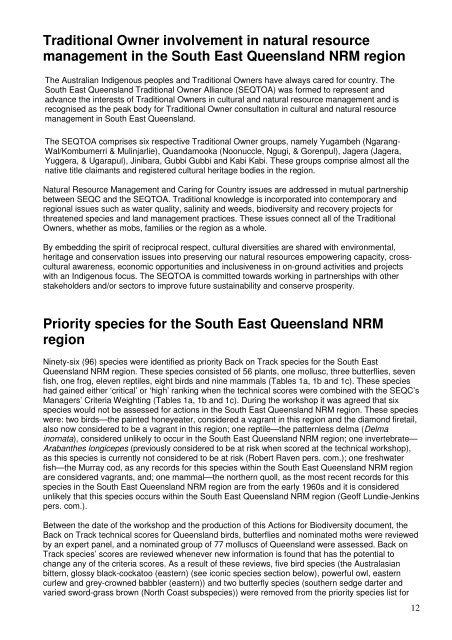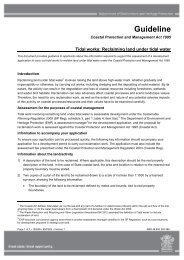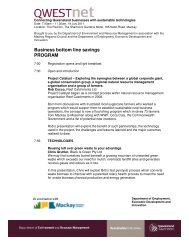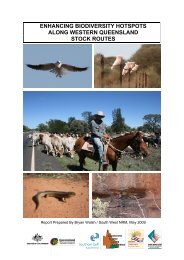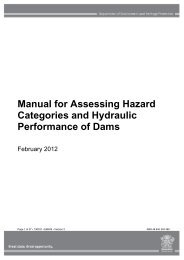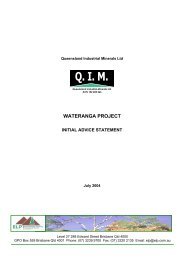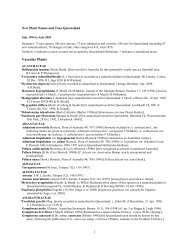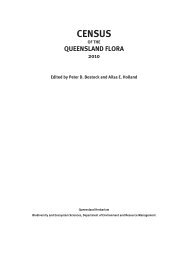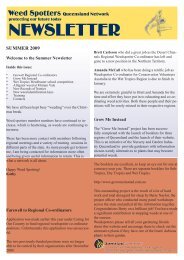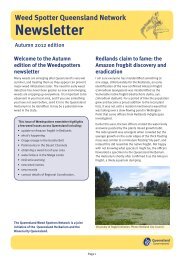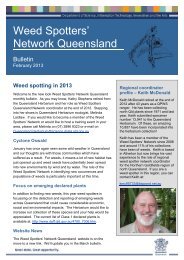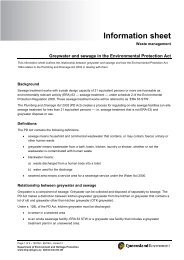Priority species - Department of Environment and Heritage Protection
Priority species - Department of Environment and Heritage Protection
Priority species - Department of Environment and Heritage Protection
Create successful ePaper yourself
Turn your PDF publications into a flip-book with our unique Google optimized e-Paper software.
Traditional Owner involvement in natural resource<br />
management in the South East Queensl<strong>and</strong> NRM region<br />
The Australian Indigenous peoples <strong>and</strong> Traditional Owners have always cared for country. The<br />
South East Queensl<strong>and</strong> Traditional Owner Alliance (SEQTOA) was formed to represent <strong>and</strong><br />
advance the interests <strong>of</strong> Traditional Owners in cultural <strong>and</strong> natural resource management <strong>and</strong> is<br />
recognised as the peak body for Traditional Owner consultation in cultural <strong>and</strong> natural resource<br />
management in South East Queensl<strong>and</strong>.<br />
The SEQTOA comprises six respective Traditional Owner groups, namely Yugambeh (Ngarang-<br />
Wal/Kombumerri & Mulinjarlie), Qu<strong>and</strong>amooka (Noonuccle, Ngugi, & Gorenpul), Jagera (Jagera,<br />
Yuggera, & Ugarapul), Jinibara, Gubbi Gubbi <strong>and</strong> Kabi Kabi. These groups comprise almost all the<br />
native title claimants <strong>and</strong> registered cultural heritage bodies in the region.<br />
Natural Resource Management <strong>and</strong> Caring for Country issues are addressed in mutual partnership<br />
between SEQC <strong>and</strong> the SEQTOA. Traditional knowledge is incorporated into contemporary <strong>and</strong><br />
regional issues such as water quality, salinity <strong>and</strong> weeds, biodiversity <strong>and</strong> recovery projects for<br />
threatened <strong>species</strong> <strong>and</strong> l<strong>and</strong> management practices. These issues connect all <strong>of</strong> the Traditional<br />
Owners, whether as mobs, families or the region as a whole.<br />
By embedding the spirit <strong>of</strong> reciprocal respect, cultural diversities are shared with environmental,<br />
heritage <strong>and</strong> conservation issues into preserving our natural resources empowering capacity, crosscultural<br />
awareness, economic opportunities <strong>and</strong> inclusiveness in on-ground activities <strong>and</strong> projects<br />
with an Indigenous focus. The SEQTOA is committed towards working in partnerships with other<br />
stakeholders <strong>and</strong>/or sectors to improve future sustainability <strong>and</strong> conserve prosperity.<br />
<strong>Priority</strong> <strong>species</strong> for the South East Queensl<strong>and</strong> NRM<br />
region<br />
Ninety-six (96) <strong>species</strong> were identified as priority Back on Track <strong>species</strong> for the South East<br />
Queensl<strong>and</strong> NRM region. These <strong>species</strong> consisted <strong>of</strong> 56 plants, one mollusc, three butterflies, seven<br />
fish, one frog, eleven reptiles, eight birds <strong>and</strong> nine mammals (Tables 1a, 1b <strong>and</strong> 1c). These <strong>species</strong><br />
had gained either ‘critical’ or ‘high’ ranking when the technical scores were combined with the SEQC’s<br />
Managers’ Criteria Weighting (Tables 1a, 1b <strong>and</strong> 1c). During the workshop it was agreed that six<br />
<strong>species</strong> would not be assessed for actions in the South East Queensl<strong>and</strong> NRM region. These <strong>species</strong><br />
were: two birds—the painted honeyeater, considered a vagrant in this region <strong>and</strong> the diamond firetail,<br />
also now considered to be a vagrant in this region; one reptile—the patternless delma (Delma<br />
inornata), considered unlikely to occur in the South East Queensl<strong>and</strong> NRM region; one invertebrate—<br />
Arabanthes longicepes (previously considered to be at risk when scored at the technical workshop),<br />
as this <strong>species</strong> is currently not considered to be at risk (Robert Raven pers. com.); one freshwater<br />
fish—the Murray cod, as any records for this <strong>species</strong> within the South East Queensl<strong>and</strong> NRM region<br />
are considered vagrants, <strong>and</strong>; one mammal—the northern quoll, as the most recent records for this<br />
<strong>species</strong> in the South East Queensl<strong>and</strong> NRM region are from the early 1960s <strong>and</strong> it is considered<br />
unlikely that this <strong>species</strong> occurs within the South East Queensl<strong>and</strong> NRM region (Ge<strong>of</strong>f Lundie-Jenkins<br />
pers. com.).<br />
Between the date <strong>of</strong> the workshop <strong>and</strong> the production <strong>of</strong> this Actions for Biodiversity document, the<br />
Back on Track technical scores for Queensl<strong>and</strong> birds, butterflies <strong>and</strong> nominated moths were reviewed<br />
by an expert panel, <strong>and</strong> a nominated group <strong>of</strong> 77 molluscs <strong>of</strong> Queensl<strong>and</strong> were assessed. Back on<br />
Track <strong>species</strong>’ scores are reviewed whenever new information is found that has the potential to<br />
change any <strong>of</strong> the criteria scores. As a result <strong>of</strong> these reviews, five bird <strong>species</strong> (the Australasian<br />
bittern, glossy black-cockatoo (eastern) (see iconic <strong>species</strong> section below), powerful owl, eastern<br />
curlew <strong>and</strong> grey-crowned babbler (eastern)) <strong>and</strong> two butterfly <strong>species</strong> (southern sedge darter <strong>and</strong><br />
varied sword-grass brown (North Coast sub<strong>species</strong>)) were removed from the priority <strong>species</strong> list for<br />
12
the South East Queensl<strong>and</strong> NRM region, <strong>and</strong> one bird <strong>species</strong> (the little tern) <strong>and</strong> one butterfly<br />
<strong>species</strong> (varied sword-grass brown (Queensl<strong>and</strong> sub<strong>species</strong>)) were added. As a result <strong>of</strong> the mollusc<br />
assessment, one snail <strong>species</strong> (Bennett’s woodl<strong>and</strong> snail) was added to the priority list for the South<br />
East Queensl<strong>and</strong> NRM region. These changes have been recognised in this document (Tables 1b<br />
<strong>and</strong> 1c).<br />
Between the date <strong>of</strong> the workshop <strong>and</strong> the production <strong>of</strong> this Actions for Biodiversity document there<br />
has been changes to the categories <strong>and</strong> names <strong>of</strong> some <strong>species</strong> under the Nature Conservation Act<br />
1992. Consequently, a number <strong>of</strong> <strong>species</strong> may require re-assessment under Back on Track because<br />
<strong>of</strong> new information received, <strong>and</strong> re-assessment may change the Back on Track rank for these priority<br />
<strong>and</strong> Data Deficient <strong>species</strong>.<br />
A separate Managers’ Criteria Weighting was carried out by relevant senior DERM managers, <strong>and</strong><br />
this weighting was used to generate a list <strong>of</strong> priority <strong>species</strong> for management by DERM. Although the<br />
full DERM priority <strong>species</strong> list is not presented in this report, the DERM (Statewide) ranking for the<br />
South East Queensl<strong>and</strong> NRM region priority <strong>species</strong> is indicated in Tables 1a, 1b <strong>and</strong> 1c.<br />
Climate Change<br />
The Back on Track <strong>species</strong> prioritisation framework commenced in 2005, with most <strong>species</strong><br />
assessment <strong>and</strong> regional workshops taking place between 2005 <strong>and</strong> 2008. Since that time,<br />
information on climate change <strong>and</strong> its likely impacts on biodiversity has become more reliable <strong>and</strong><br />
detailed (Steffen et al. 2009), <strong>and</strong> more advanced directions for State <strong>and</strong> National climate change<br />
policies have emerged (DERM 2009; National Biodiversity Strategy Review Task Group 2009). Many<br />
actions identified by Back on Track concur with the key messages <strong>and</strong> policy directions <strong>of</strong> these<br />
recent documents. However, some aspects <strong>of</strong> Back on Track will need to be modified <strong>and</strong> updated in<br />
response to this new information.<br />
Improving l<strong>and</strong>scape connectivity <strong>and</strong> building resilience will be key strategies to ensure that natural<br />
systems have the capacity to adapt to shifting climatic zones (National Biodiversity Strategy Review<br />
Task Group 2009) <strong>and</strong> the acceleration <strong>of</strong> actions to control <strong>and</strong> reduce existing stressors on<br />
Australian ecosystems <strong>and</strong> <strong>species</strong> is essential to increase resilience (Steffen et al. 2009). Back on<br />
Track has identified numerous priority actions to improve connectivity by addressing habitat<br />
fragmentation <strong>and</strong> even more Back on Track actions have been formulated to improve the resilience<br />
<strong>of</strong> <strong>species</strong> <strong>and</strong> ecosystems by managing existing stressors (e.g. feral animals, weeds, fire regime <strong>and</strong><br />
grazing regime). In this way, Back on Track is already implementing the recommendations <strong>of</strong> Steffen<br />
et al. (2009) <strong>and</strong> the National Biodiversity Strategy Review Task Group (2009) to improve the capacity<br />
<strong>of</strong> threatened <strong>species</strong> to adapt to climate change.<br />
However, there is a limit to how far enhancing resilience will be effective, <strong>and</strong> a major rethink is<br />
needed to develop new policy <strong>and</strong> management tools to conserve biodiversity in a changing climate<br />
(Steffen et al. 2009). Future Back on Track workshops will be able to use the new information<br />
available on the predicted regional impacts <strong>of</strong> climate change. ClimateQ summaries provide<br />
projections for changes in temperature, rainfall <strong>and</strong> evaporation in each <strong>of</strong> 13 regions for 2030 (under<br />
a medium emissions scenario), <strong>and</strong> for 2050 <strong>and</strong> 2070 (under low <strong>and</strong> high emissions scenarios).<br />
More information on the ClimateQ regional summaries is available on the Office <strong>of</strong> Climate Change<br />
website <strong>and</strong> can be used to identify actions that will be more<br />
responsive to climate change.<br />
If the information is available, Back on Track should aim to formulate management strategies that<br />
‘hedge our bets’ against different climate change scenarios. This can be done by identifying the<br />
actions needed to conserve <strong>species</strong> under a variety <strong>of</strong> future climate change scenarios. The actions<br />
that would be effective under all climate change scenarios become ‘no regrets’ management actions,<br />
<strong>and</strong> these actions should be the highest priority for implementation.<br />
Some modification to the methods used to assess <strong>species</strong> may also be needed. For example, Back<br />
on Track <strong>species</strong> assessments currently only focus on major threats likely to occur in the next five<br />
years. This is to prevent the dissipation <strong>of</strong> resources on minor <strong>and</strong> potential future threats that may<br />
not happen. However, this means that major future threats (beyond five years) that are likely to<br />
happen (e.g. climate change) are not considered when scoring Criterion 3a. To make the best use <strong>of</strong><br />
13
the new information available on the impacts <strong>of</strong> climate change <strong>and</strong> other threats, consideration will<br />
be given to scoring major threats to <strong>species</strong> that are likely to occur within a longer time period into the<br />
future.<br />
Iconic <strong>species</strong><br />
The Back on Track <strong>species</strong> prioritisation method uses a combination <strong>of</strong> factors to determine priority<br />
<strong>species</strong> for the State <strong>and</strong> each Natural Resource Management region. These include assessing<br />
whether a <strong>species</strong> is ‘threatened’ using IUCN criteria (traditional approach) <strong>and</strong> also asking questions<br />
about importance to the community, knowledge <strong>of</strong> threats, whether action can be taken to address<br />
threats <strong>and</strong> what resources will be required to recover the <strong>species</strong>. In addition, senior managers for<br />
each region <strong>and</strong> the State weight the criteria to reflect the priorities for conservation resources in their<br />
region. (Refer methodology: ).<br />
The prioritisation method treats iconic <strong>species</strong> in the same manner as non-iconic <strong>species</strong>. That is,<br />
their iconic status does not mean they automatically become priority <strong>species</strong>. They do, however,<br />
score highly on the importance to the community criteria.<br />
Two iconic <strong>species</strong> (koala <strong>and</strong> glossy black-cockatoo (eastern)) have been assessed as ‘medium’<br />
priority rather than ‘critical’ or ‘high’ priority in the South East Queensl<strong>and</strong> NRM region as some might<br />
expect.<br />
The glossy black-cockatoo (eastern) has been assessed as a State priority but following the bird<br />
review <strong>and</strong> application <strong>of</strong> SEQC weighting criteria this <strong>species</strong> is now a medium priority for the SEQ<br />
NRM region. It should be noted that as a State priority, DERM will continue to place resources to<br />
addressing threats that impact on this <strong>species</strong>.<br />
Though the koala population in the South East Queensl<strong>and</strong> NRM region is under significant threat,<br />
the assessment is made for the population across the whole state. Overall, koalas in<br />
Queensl<strong>and</strong> were assessed as not fulfilling the requirements <strong>of</strong> ‘threatened’ status under the IUCN<br />
criteria. Subsequently the <strong>species</strong> is ranked as a ‘medium’ priority under the Back on Track <strong>species</strong><br />
prioritisation framework.<br />
The koala in particular is <strong>of</strong> significant social value <strong>and</strong> is very important to the tourism economy.<br />
The State Government has instigated a koala crisis response strategy in South East<br />
Queensl<strong>and</strong>.<br />
The Back on Track <strong>species</strong> prioritisation framework does not prevent interest groups <strong>and</strong> others<br />
placing conservation effort <strong>and</strong> resources towards iconic <strong>species</strong> or any other <strong>species</strong>. Instead, the<br />
framework recognises that conservation investment resources are scarce <strong>and</strong> so guides where<br />
conservation effort will have the most strategic value <strong>and</strong> greatest chance <strong>of</strong> success.<br />
The various taxonomic groups will be subject to a review process every few years. New information<br />
on iconic <strong>and</strong> other <strong>species</strong> can be taken into account at that time.<br />
Data deficient <strong>species</strong><br />
Some <strong>species</strong> were considered to be too poorly known about to receive scores for all seven Back on<br />
Track criteria. These <strong>species</strong> are referred to as ‘data deficient’ <strong>and</strong> are priorities for research or<br />
taxonomic work. The data deficient <strong>species</strong> found in the South East Queensl<strong>and</strong> NRM region are<br />
listed in Appendix 2.<br />
14
Table 1a. Back on Track priority plant <strong>species</strong> for the South East Queensl<strong>and</strong> NRM region. SEQ = South<br />
East Queensl<strong>and</strong> rank, Statewide = rank determined by <strong>Department</strong> <strong>of</strong> <strong>Environment</strong> <strong>and</strong> Resource<br />
Management criteria weighting exercise, C = Critical priority, H = High priority, M = Medium priority. See<br />
Appendix 1 for threatened <strong>species</strong> listing under State <strong>and</strong> Commonwealth legislation.<br />
Species Name<br />
Common Name<br />
Back on Track rank<br />
SEQ Statewide<br />
Acacia attenuata H H<br />
Acacia baueri subsp. baueri H M<br />
Acacia saxicola Mt. Maroon wattle H M<br />
Aponogeton elongatus subsp. elongatus H M<br />
Arthropodium sp. (Mt Cordeaux P.I.Forster+ PIF22065) C H<br />
Bl<strong>and</strong>fordia gr<strong>and</strong>iflora Christmas bells H H<br />
Boronia keysii Key's boronia H H<br />
Boronia safrolifera H M<br />
Brachychiton sp. (Ormeau L.H.Bird AQ435851) Ormeau bottle tree H M<br />
Brunoniella spiciflora H H<br />
Callitris baileyi Bailey's cypress C H<br />
Caustis blakei subsp. macrantha C C<br />
Chamaecrista maritima H H<br />
Corchorus cunninghamii Cunningham's jute H H<br />
Corynocarpus rupestris subsp. arborescens southern corynocarpus H M<br />
Cupaniopsis newmanii long-leaved tuckeroo H M<br />
Cupaniopsis shirleyana H H<br />
Davidsonia johnsonii smooth Davidsonia H H<br />
Discaria pubescens H M<br />
Durringtonia paludosa C H<br />
Eucalyptus bancr<strong>of</strong>tii Bancr<strong>of</strong>t's red gum H M<br />
Eucalyptus conglomerata H M<br />
Euphrasia bella Laminton eyebright C C<br />
Glycyrrhiza acanthocarpa native liquorice H M<br />
Gossia gonoclada angle-stemmed myrtle H M<br />
Hydrocharis dubia frogbit H M<br />
Lepidosperma quadrangulatum C C<br />
Lilaeopsis brisbanica H H<br />
Macarthuria complanata H H<br />
Macrozamia pauli-guilielmi H C<br />
Melaleuca groveana H M<br />
Melaleuca irbyana swamp tea tree H M<br />
Ochrosia moorei southern ochrosia H H<br />
Owenia cepiodora onion cedar H M<br />
Ozothamnus vagans birdwing vine H M<br />
Pararistolochia praevenosa H H<br />
Phaius australis C C<br />
Phaius bernaysii yellow swamp orchid C C<br />
Phebalium distans C H<br />
Picris conyzoides H H<br />
Picris evae H H<br />
Platysace sp. (Mt Ninderry P.R.Sharpe+ 2092) C H<br />
Rhaponticum australe C H<br />
Romnalda strobilacea H M<br />
Sarcochilus fitzgeraldii ravine orchid C C<br />
Sarcochilus hartmannii C C<br />
Sarcochilus weinthalii C C<br />
Selaginella <strong>and</strong>rewsii H M<br />
15
Table 1a. Back on Track priority plant <strong>species</strong> for the South East Queensl<strong>and</strong> NRM region (continued).<br />
Species Name Common Name<br />
Back on Track rank<br />
SEQ Statewide<br />
Seringia sp. (Chermside S.T.Blake 23068) H H<br />
Swainsona fraseri H M<br />
Syzygium moorei Durobby H M<br />
Tephrosia sp. (Wyreema R.J.Fensham 2082) H M<br />
Thismia rodwayi H M<br />
Triunia robusta H H<br />
Zieria exsul H M<br />
Zieria furfuracea subsp. gymnocarpa C C<br />
16
Table 1b. Back on Track priority invertebrate, fish, frog <strong>and</strong> reptile <strong>species</strong> for the South East<br />
Queensl<strong>and</strong> NRM region. SEQ = South East Queensl<strong>and</strong> rank, Statewide = rank determined by <strong>Department</strong> <strong>of</strong><br />
<strong>Environment</strong> <strong>and</strong> Resource Management criteria weighting exercise, C = Critical priority, H = High priority, M =<br />
Medium priority. See Appendix 1 for threatened <strong>species</strong> listing under State <strong>and</strong> Commonwealth legislation.<br />
Species Name<br />
Molluscs<br />
Common Name<br />
Back on Track rank<br />
SEQ Statewide<br />
Pallidelix bennetti (Brazier, 1872)<br />
Bennett’s woodl<strong>and</strong> snail<br />
comb. nov.<br />
Butterflies <strong>and</strong> moths<br />
H M<br />
Acrodipsas illidgei Illidge's ant-blue butterfly C C<br />
Ornithoptera richmondia Richmond birdwing butterfly H C<br />
Tisiphone abeona rawnsleyi<br />
Fish<br />
varied sword-grass brown (Queensl<strong>and</strong> sub<strong>species</strong>) H M<br />
Achoerodus viridis eastern blue groper H C<br />
Carcharodon carcharias white shark H C<br />
Dasyatis fluviorum estuary stingray H H<br />
Heteroscyllium colcloughi Colcloughs shark H M<br />
Nannoperca oxleyana Oxleyan pygmy perch C C<br />
Pseudomugil mellis honey blue-eye C C<br />
Rhadinocentrus ornatus<br />
Frogs<br />
ornate rainbowfish H H<br />
Crinia tinnula<br />
Reptiles<br />
wallum froglet H H<br />
Caretta caretta loggerhead turtle C C<br />
Chelonia mydas green turtle C C<br />
Coeranoscincus reticulatus three-toed snake-tooth skink H M<br />
Delma plebeia common delma H M<br />
Delma torquata collared delma H H<br />
Dermochelys coriacea leatherback turtle H C<br />
Eretmochelys imbricata hawksbill turtle C C<br />
Eroticoscincus graciloides elf skink H M<br />
Hemiaspis damelii grey snake H M<br />
Hoplocephalus bitorquatus pale-headed snake H M<br />
Hoplocephalus stephensii Stephens' b<strong>and</strong>ed snake C H<br />
17
Table 1c. Back on Track priority bird <strong>and</strong> mammal <strong>species</strong> for the South East Queensl<strong>and</strong> NRM region.<br />
SEQ = South East Queensl<strong>and</strong> rank, Statewide = rank determined by <strong>Department</strong> <strong>of</strong> <strong>Environment</strong> <strong>and</strong><br />
Resource Management criteria weighting exercise, C = Critical priority, H = High priority, M = Medium priority.<br />
See Appendix 1 for threatened <strong>species</strong> listing under State <strong>and</strong> Commonwealth legislation.<br />
Species Name<br />
Birds<br />
Common Name<br />
Back on Track rank<br />
SEQ Statewide<br />
Atrichornis rufescens rufous scrub-bird C C<br />
Cyclopsitta diophthalma coxeni Coxen's fig-parrot C C<br />
Dasyornis brachypterus eastern bristlebird H H<br />
Erythrotriorchis radiatus red goshawk H H<br />
Esacus magnirostris beach stone-curlew H H<br />
Pezoporus wallicus wallicus ground parrot H H<br />
Sternula albifrons little tern H H<br />
Turnix melanogaster black-breasted button-quail C C<br />
Mammals<br />
Dasyurus maculatus maculatus spotted-tailed quoll (southern sub<strong>species</strong>) H H<br />
Dugong dugon dugong C C<br />
Kerivoula papuensis golden-tipped bat H M<br />
Petaurus australis australis yellow-bellied glider (southern sub<strong>species</strong>) H H<br />
Petrogale penicillata brush-tailed rock-wallaby H H<br />
Pteropus poliocephalus grey-headed flying-fox C C<br />
Scoteanax rueppellii greater broad-nosed bat H M<br />
Sousa chinensis Indo-Pacific humpback dolphin C C<br />
Xeromys myoides water mouse (false water-rat) C H<br />
18


